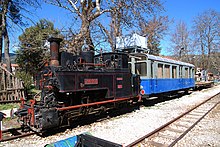Diakopto – Kalavryta railway line
| Diakopto – Kalavryta | |||||||||||||||||||||||||||||||||||||
|---|---|---|---|---|---|---|---|---|---|---|---|---|---|---|---|---|---|---|---|---|---|---|---|---|---|---|---|---|---|---|---|---|---|---|---|---|---|
|
Vouraikos gorge between Diakopto and Kalavryta
| |||||||||||||||||||||||||||||||||||||
| Route length: | 22.3 km | ||||||||||||||||||||||||||||||||||||
| Gauge : | 750 mm ( narrow gauge ) | ||||||||||||||||||||||||||||||||||||
| Maximum slope : | 140 ‰ | ||||||||||||||||||||||||||||||||||||
| Rack system : | Dept | ||||||||||||||||||||||||||||||||||||
|
|||||||||||||||||||||||||||||||||||||
The railway Diakopto-Kalavryta ( Greek Οδοντωτός σιδηρόδρομος Διακοπτού - Καλαβρύτων ) is a 22 km long narrow gauge railway line in the north of the Peloponnese in Greece , the port city of Diakopto at the Gulf of Corinth (Κορινθιακός Κόλπος) with Kalavryta connects to the underlying mountains. It is operated by the Organismos Sidirodromon Ellados (OSE).
history

The railway line was built between 1889 and 1896. She also opened up the Megaspiläon Monastery , an important Greek national shrine , and the area around Kalavryta. It was also planned to extend the route across the Peloponnese to Tripoli . Due to the very demanding topography, this first section already required a technically complex, cost-intensive solution, which was also not operationally compatible with the Corinth - Patras railway line built in meter gauge . A narrow-gauge railway has been constructed gauge 750 mm with gear operation after the system Abt between the foot of the mountain and Megaspiläon. The maximum gradient is 140 per thousand. The line to Tripoli was therefore not continued.
The route was originally operated by steam locomotives . One of them (company number ΔΚ1 or ΔΚ8001, built by the French company Anciens Établissements Cail ) has been refurbished and can be used for special trips . Another is set up as a technical monument at Diakopto station. In 1959, three electric railcars (ΑΔΚ 01 to 03, now ΑΒδφπτ 3001 to 3003) and associated control cars were acquired by the Établissements Billard . Since the money for electrification was lacking, two-axle generator cars were procured, which were placed between the control car and the railcar and supply the electricity for operation. In 1967 three more corresponding units (ΑΒδφπτ 3004 to 3006) were added, which were supplied by Decauville .
The landscape of the route is impressive. Apart from the short section that leads to the foot of the mountains, it runs almost exclusively on the slope and partly in the wall of the rocky gorge of the Vouraïkos . The E4 European long-distance hiking trail also runs along the route . The attitude was discussed again and again, because today the railway - apart from its tourist aspect - has hardly any economic importance. However, in 2007 Deutsche Bahn acquired four new multiple units (ΑΒδφπτ 3007 to 3010) from Stadler Rail , designated as OSE BDmh 2Z + 4A / 12 , and renovated the route from scratch in 2008/2009. The steel bridges were renovated and the superstructure renewed. The repair cost around 40 million euros. On July 2nd, 2009 the line was reopened.
literature
- Hans-Bernhard Schönborn: Narrow Gauge Railways in Greece , Edition Ergasias, 1997, ISBN 3-909221-32-7
- klon / sön: GTW reaches Kalavrita . In: Eisenbahn-Revue International 7/2009, p. 368.
Web links
- Odontotos rack railway, Οδοντωτός σιδηρόδρομος Διακοπτού - Καλαβρύτων , English and Greek








